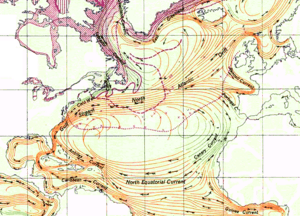North Atlantic Gyre facts for kids
The North Atlantic Gyre is like a giant, slow-moving swirl of water in the Atlantic Ocean. Think of it as a huge ocean current that goes in a big circle. It stretches from the warm, calm waters near the equator (called the Intertropical Convergence Zone) all the way up to the area south of Iceland. It also reaches from the east coast of North America to the west coasts of Europe and Africa.
This massive gyre is made up of several important ocean currents. These include the Gulf Stream in the west, which then becomes the North Atlantic Current as it moves across the north. On the eastern side, the Canary Current flows south, and in the south, there's the North Equatorial Current. The gyre also plays a big role in moving salty water from the Mediterranean Sea northwards, helping to form deep ocean currents.
Sadly, the North Atlantic Gyre can trap human-made trash, creating a "garbage patch." This is similar to the Great Pacific garbage patch found in the North Pacific Gyre. Right in the middle of this huge swirl of water is the Sargasso Sea, which is known for its calm waters and lots of seaweed.
How the Gyre Changes with Seasons
Just like the weather, ocean patterns like the North Atlantic Gyre change throughout the year. Scientists have found that the gyre gets bigger and smaller with the seasons.
During the Northern Hemisphere winter, the gyre stretches out more from east to west, becoming a bit thinner from north to south. As winter turns into summer, the gyre shifts a few degrees south.
Scientists have studied the Sargasso Sea area to understand these changes. They found that the water's surface temperature can change by 8-10 °C between winter and summer. The "mixed layer" (the top part of the ocean where water mixes easily) also changes depth. In winter, it can be 200 meters deep, but in summer, it's only about 10 meters deep.
Most of the year, important nutrients for tiny ocean plants (called phytoplankton) stay deep below the surface. But in winter, when the water mixes more, these nutrients come closer to the surface. This causes a quick burst of phytoplankton growth in the spring, which then makes the mixed layer shallower.
These seasonal changes also affect how much carbon dioxide is in the seawater. Scientists have noticed that carbon dioxide levels in this gyre are increasing at a similar rate to the atmosphere. This is a discovery also made in the North Pacific Gyre. The gyre's temperature also changes because of big atmospheric patterns, like the North Atlantic Oscillation (NAO). When the NAO is in a certain phase, the gyre warms up.
Lead Pollution in the Gyre
Scientists have studied samples of air particles, ocean particles, and water from the gyre between 1990 and 1992. They looked at different types of lead to see where pollution was coming from. Some lead came from Europe and the Middle East, carried by trade winds. Other pollution mainly came from American sources.
The top layers of the Sargasso Sea showed these lead levels. About 42–57% of the lead pollution came from American factories and cars, even though the use of leaded gasoline was reduced in the United States. Since 1992, lead levels have clearly been going down, which is good news for the ocean.
Garbage Patch
The North Atlantic garbage patch is a huge area in the Atlantic Ocean where lots of human-made trash floats. It's a type of garbage patch made of marine debris, which means rubbish found in the sea. This patch was first noticed in 1972. It floats inside a giant ocean current system called the North Atlantic Gyre.
Scientists from the Sea Education Association studied this patch for 22 years. They believe it is hundreds of kilometers wide. It can have over 200,000 pieces of trash in just one square kilometer. Most of this trash comes from human waste that travels from rivers into the ocean. It is mainly made up of tiny plastic pieces called microplastics.
This garbage patch is very dangerous for ocean animals and even for humans. Animals can eat the plastic or get tangled in it. Not many groups have worked to clean up the North Atlantic garbage patch. Most efforts have focused on the Great Pacific garbage patch, which is a similar area in the Pacific Ocean.See also
 In Spanish: Giro del Atlántico Norte para niños
In Spanish: Giro del Atlántico Norte para niños


